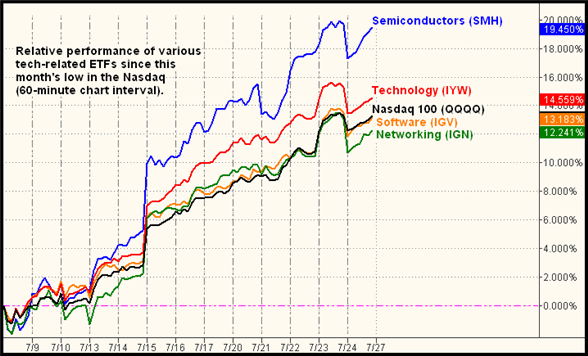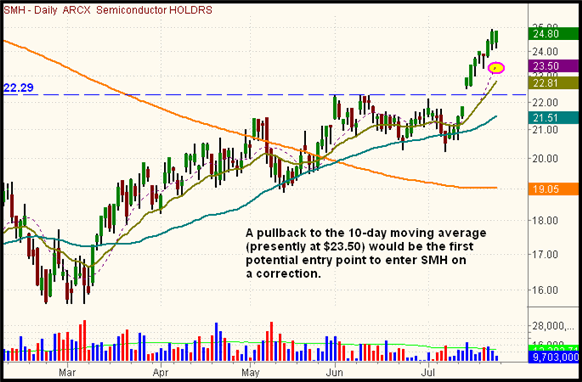|
The Wagner Daily ETF Report For July 27
A negative reaction to earnings reports from several tech companies on the evening of June 23 caused the major indices to open substantially lower last Friday, but the bulls remained in control. After a bit of morning weakness, stocks reversed course and trended higher throughout the day. The main stock market indexes subsequently closed near their best levels of the day, and with mixed results. Snapping its amazing, twelve-day winning streak, the Nasdaq Composite reversed an intraday loss of 1.8% to finish just 0.4% lower. The S&P 500 and Dow Jones Industrial Average registered identical gains of 0.3%. The small-cap Russell 2000 advanced 0.5%, as the S&P Midcap 400 ticked 0.6% higher.
Turnover eased across the board. Total volume in the NYSE was 26% lighter than the previous day's level, while volume in the Nasdaq similarly receded 25%. Volume in both exchanges fell back below 50-day average levels. Market internals started out firmly negative, especially in the Nasdaq, but steadily improved as the day progressed. Advancing volume in the NYSE exceeded declining volume by just under 2 to 1. The Nasdaq adv/dec volume spread managed to settle marginally positive.
As promised in last Friday's commentary, let's take a look at strong ETFs that may provide nice entry points if they pullback to support this week. Since the breakout in the Semiconductor Index ($SOX) on July 15, we've been stalking several of the tech ETFs for ideal pullback entry points. Since the Nasdad's recent uptrend has been rather parabolic, we've yet to see a significant retracement, or even short-term consolidation in the tech ETFs. However, with the Nasdaq finally having a losing session last Friday, it's quite possible we'll see at least a brief pullback, or at least the formation of a sideways base, in the coming week. If that occurs, we want to be prepared with knowing which ETFs are showing the most relative strength, as well as approximate levels to consider buy entries.
When a broad industry sector, such as technology, is rallying sharply, it can sometimes be difficult to determine which specific ETF within the group has the most relative strength. Right now, for example, we know the tech stocks have been hot, but are sub-sectors such as semiconductor and software leading the way over general, broad-based tech ETFs? The quickest and easiest way to find out is through the use of a chart known as a "percentage change chart."
As detailed in my latest book, Trading ETFs: Gaining An Edge With Technical Analysis, the percentage change chart is ideal for comparing the relative price performance of a handful of individual ETFs. Rather than plotting prices, this type of chart simply plots the percentage an equity has risen or fallen over a given period of time. When numerous ETFs are overlaid on the same chart, it becomes much easier to spot stocks and ETFs with the most relative strength within the group. Below, we've plotted several tech-related ETFs on a percentage change chart that shows their relative price performance since the Nasdaq's lowest level of July:

With just a quick glance, the chart above enables one to see which sub-sector of the technology arena has been performing the best. Of the ETFs we've compared, the winner is Semiconductor HOLDR (SMH), which has gained more than 19% within the past two weeks. By comparison, the benchmark Nasdaq 100 Tracking Stock (QQQQ) has increased "only" 13% during the same period. Faring slightly better than the performance of the Nasdaq 100 was iShares Technology (IYW), which gained 14.5%. Lagging slightly behind the Nasdaq 100 was iShares Software (IGV) and iShares Computer Networking (IGN). Armed with the knowledge of which industry ETF has been showing the most relative strength within the technology sector (SMH), we next look at the daily chart of SMH in order to determine a suitable buy entry point. The daily chart of SMH is shown below:

The dashed horizontal line on the SMH chart above marks its key breakout above resistance, which occurred on July 15. Often, an ETF will immediately pullback to test support of its breakout level within one to two days later, providing a low-risk, secondary entry point, but that didn't happen this time. Instead, SMH immediately zoomed higher, closing with a gain in seven of the past eight sessions. As such, our next entry point to take advantage of the strength in this sector would be a pullback to the 10-day moving average (the dotted purple line, circled in pink). Though we discuss the significance of the 20-day moving average much more than the 10-day moving average, we've found the 10-day moving average to effectively act as support in very strongly trending stocks and ETFs. The problem with the 20-day moving average is that very strong equities often do not even touch their 20-day moving averages before making another leg up.
Going into this week, we'll be looking for strong ETFs, such as SMH, that pull back to support of their 10-day moving averages, and other similar areas of support (such as the 20-EMA on the 60-minute chart). Even if they don't retrace much, a period of sideways consolidation (a correction by time) would also allow the rising moving averages to meet the price of the ETFs, which also could provide entry points as well. Over the next few days, we'll also be analyzing the charts of other, non-tech ETFs that look pretty good right now (such as international ones). As always, regular subscribers will be notified by Intraday Trade Alert if/when we enter anything new.
Open ETF positions:
Long - DGP, FXY
Short - (none)
Deron Wagner is the Founder and Head Trader of both Morpheus Capital LP, a U.S. hedge fund, and MorpheusTrading.com, a trader education firm.
|